
Final Fantasy VII is a 1997 role-playing video game developed by Square for the PlayStation console. It is the seventh main installment in the Final Fantasy series. Published in Japan by Square, it was released in other regions by Sony Computer Entertainment and became the first in the main series to see a PAL release. The game's story follows Cloud Strife, a mercenary who joins an eco-terrorist organization to stop a world-controlling megacorporation from using the planet's life essence as an energy source. Events send Cloud and his allies in pursuit of Sephiroth, a superhuman who seeks to wound the planet and harness its healing power in order to be reborn as a demigod. During the journey, Cloud builds close friendships with his party members, including Aerith Gainsborough, who holds the secret to saving their world.

Cloud Strife is a fictional character and the main protagonist of Square's 1997 role-playing video game Final Fantasy VII, its high-definition remake, and several of its sequels and spinoffs. In Final Fantasy VII, Cloud is a mercenary claiming to be formerly of SOLDIER, a group of elite supersoldiers employed by the Shinra Electric Power Company, a megacorporation responsible for draining the life from the planet. Relying solely on his large broadsword, Cloud joins the resistance group AVALANCHE in the fight against Shinra, and driven by a feud with his former superior, the primary antagonist Sephiroth who attempts to conquer the world, Cloud learns to accept his troubled past and adapts to his role as a leader.

Itadaki Street is a party video game series originally created by Dragon Quest designer Yuji Horii. It is currently owned by Square Enix and Kadokawa. The first game was released in Japan on Nintendo's Famicom console in 1991. Since then, new installments in the series have been released for the Super Famicom, PlayStation, PlayStation 2, PlayStation Portable, Nintendo DS, Mobile Phones, Android, iOS, PlayStation 4 and PlayStation Vita. The series was exclusive to Japan prior to the 2011 Itadaki Street Wii, which is released as Fortune Street in North America and Boom Street in PAL regions.

Sephiroth is a fictional character in the Final Fantasy series, and the main antagonist of Final Fantasy VII developed by Square. He is later revealed to be the result of an experiment by the megacorporation Shinra, in which they injected him with cells from the extraterrestrial lifeform Jenova when he was still a fetus. Upon discovering this, Sephiroth becomes consumed by his rage and decides to take control of the Planet, while Cloud and the game's other protagonists attempt to stop him. Sephiroth's background and role in the story are expanded in the Compilation of Final Fantasy VII. Additionally, he appears as a guest character in other video games and media, such as a recurring boss in the Kingdom Hearts series and as a playable character in Super Smash Bros. Ultimate.
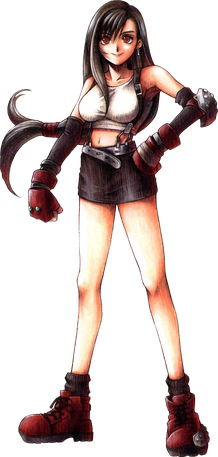
Tifa Lockhart is a character who debuted in Square's 1997 role-playing video game Final Fantasy VII. She was created as a foil to her teammate Aerith Gainsborough by members of the development team including director Yoshinori Kitase and writers Kazushige Nojima and Tetsuya Nomura; Nomura additionally contributed her visual design. She has since appeared as a playable fighter in Ehrgeiz and the Dissidia Final Fantasy series and made cameo appearances in several other titles, such as Kingdom Hearts II and Itadaki Street. Beginning in 2005, she has featured in sequels and spin-offs as part of the Compilation of Final Fantasy VII series, including the computer-animated film Advent Children and the Final Fantasy VII Remake project.
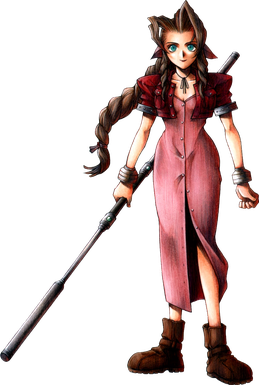
Aerith Gainsborough, transliterated as Aeris Gainsborough in the English releases of Final Fantasy VII and Final Fantasy Tactics, is a fictional character in Square's role-playing video game Final Fantasy VII. She was designed by Tetsuya Nomura with influence from Yoshinori Kitase, Hironobu Sakaguchi and Yoshitaka Amano.

Kefka Palazzo is a fictional character in the Final Fantasy series of video games. Originally designed by Yoshitaka Amano, he appears in the sixth installment of the series, Final Fantasy VI. First introduced as the court jester and army general under Emperor Gestahl, throughout the game he reveals himself to be a nihilistic psychopath after setting in motion events leading to the apocalypse and pronouncing himself as the God of Magic. From that point he acts as the game's primary antagonist.

Squall Leonhart is a fictional character and the protagonist of Final Fantasy VIII, a role-playing video game that was produced by Square. Within the game's plot, Squall is an 17-year-old student at Balamb Garden, a prestigious military academy for elite mercenaries. Forced into becoming the Commander due to his outstanding skills, Squall befriends his underlings, and falls in love with Rinoa Heartilly. These relationships, combined with the game's plot, gradually change him from being a loner to an open, caring person. Squall has appeared in several other games, including Chocobo Racing, Itadaki Street Special, and the Kingdom Hearts series as the older mentor-like figure named Leon.

Fabula Nova Crystallis Final Fantasy is a series of games within the Final Fantasy video game franchise. It was primarily developed by series creator and developer Square Enix, which also acted as publisher for all titles. While featuring various worlds and different characters, each Fabula Nova Crystallis game is ultimately based on and expands upon a common mythos focusing on important crystals tied to deities. The level of connection to the mythos varies between each title, with each development team given the freedom to adapt the mythos to fit the context of a game's story.

Dissidia Final Fantasy is a fighting game with action RPG elements developed and published by Square Enix for the PlayStation Portable as part of the campaign for the Final Fantasy series' 20th anniversary. It was released in Japan on December 18, 2008, in North America on August 25, 2009, and in Australia and Europe in September. It was then re-released in Japan, based on the North American version, as Dissidia Final Fantasy: Universal Tuning, on November 1, 2009.
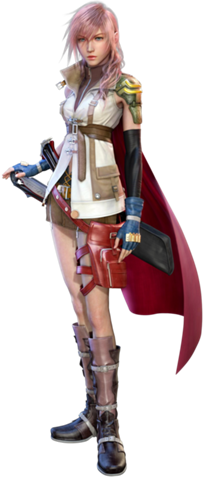
Claire Farron is a fictional character from the Final Fantasy video game series made by Square Enix. She first appeared as a playable character and the main protagonist in the role-playing video game Final Fantasy XIII, in which she features as a resident of the artificial world of Cocoon. After her sister Serah is declared an enemy of Cocoon, Lightning attempts to save her. She and others are then chosen by the fal'Cie, a divided race of demigods who rule the worlds of Gran Pulse and Cocoon, to destroy Cocoon. Lightning reappears as a supporting character in Final Fantasy XIII-2, acting as protector of the Goddess Etro. She is the sole playable character in Lightning Returns: Final Fantasy XIII, wherein she sets out to save her world, which is destined to end in thirteen days. Outside the XIII series, Lightning has been featured in multiple Final Fantasy games and had cameo appearances in other video games.
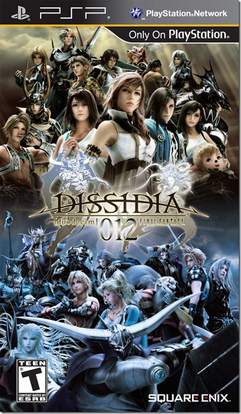
Dissidia 012 Final Fantasy is a 2011 fighting game published by Square Enix for the PlayStation Portable as part of the Final Fantasy series. It was developed by the company's 1st Production Department and released worldwide in March 2011. The game is both a prequel and remake of Dissidia Final Fantasy, revealing what occurred before the events of its predecessor.

Theatrhythm Final Fantasy is a rhythm video game, developed by indieszero and published by Square Enix for Nintendo 3DS and iOS. Based on the Final Fantasy video game franchise, the game involves using the touch screen in time to various pieces of music from the series. The game was released in Japan in February 2012, and in North America, Australia and Europe in July. An iOS version was released in December. A sequel, Theatrhythm Final Fantasy: Curtain Call, was released in 2014. A third game based on the Dragon Quest series, Theatrhythm Dragon Quest, was released in 2015. An arcade game, Theatrhythm Final Fantasy: All-Star Carnival, was released in 2016. A second sequel, Theatrhythm Final Bar Line, was released on February 16, 2023 for Nintendo Switch and PlayStation 4.

Final Fantasy Airborne Brigade, known in Japan as Final Fantasy Brigade was a Final Fantasy video game developed and published by Square Enix for Mobage compatible mobile phones. The game was similar to other traditional Final Fantasy games with an overworld and dungeons, but was socially oriented. There were over 2.5 million players just in Japan, though reviews have commented on the game's lack of polish and sound.
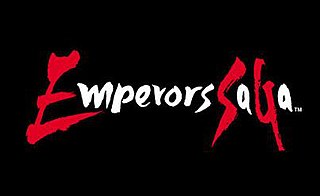
Emperors SaGa is a downloadable social game in the SaGa series from Square Enix. The game was released on the GREE platform on September 18, 2012 and on Mobage and NTT DoCoMo on November 28, 2013. It was shut down on April 28, 2017. In Emperors SaGa, players take the role of the emperor of a nation, and guide the country as its ruler.
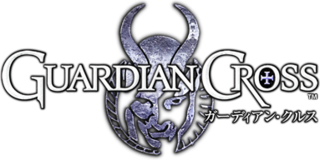
Guardian Cross is a smartphone game for iOS and Android, created by Square Enix. It was released on September 13, 2012, for iOS, and on August 5, 2013, for Android. In it, the player captures creatures to form a deck of cards that they use to battle human and computer opponents. Battles take place as turn-based matches on the device, while capturing creatures is a first person shooter mini-game. Although reviews were not complimentary towards the game, it sold well. The multiplayer servers for the game were shut down on January 10, 2017.

Dissidia Final Fantasy NT is a fighting game with action role-playing elements developed by Koei Tecmo's Team Ninja and published by Square Enix for Microsoft Windows and PlayStation 4.
Tetsuya Nomura is a Japanese video game artist, designer and director working for Square Enix. He designed characters for the Final Fantasy series, debuting with Final Fantasy VI and continuing with various later installments. Additionally, Nomura co-created and has led the development of the Kingdom Hearts series since its inception in 2002 and was the director of the 2005 film Final Fantasy VII: Advent Children.
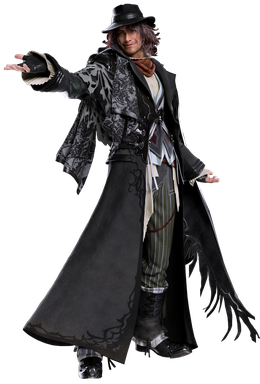
Ardyn Izunia, also known as Ardyn Lucis Caelum, is a fictional character from the Final Fantasy video game series made by Square Enix. He is the main antagonist in Final Fantasy XV (2016)−originally a spin-off title called Final Fantasy Versus XIII−a prominent character in the game's associated media, and has made appearances in other Final Fantasy products. Initially presented as chancellor of Nilfheim, the nation opposing Lucis for control of its magical Crystal, he is later revealed to be the source of a corruptive plague dubbed the Starscourge and pursuing a vendetta against the family of protagonist Noctis Lucis Caelum.


















